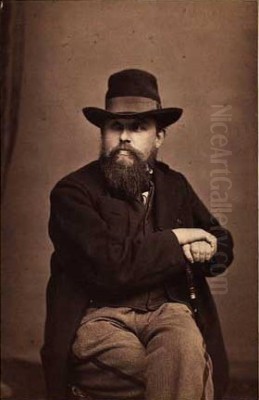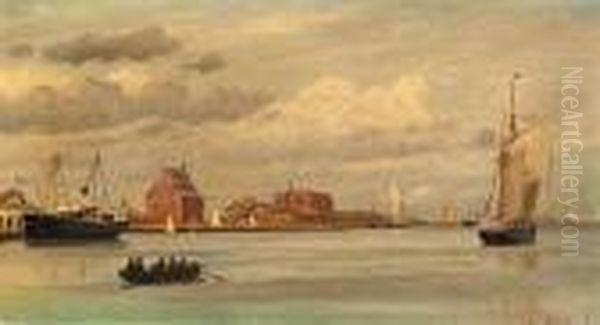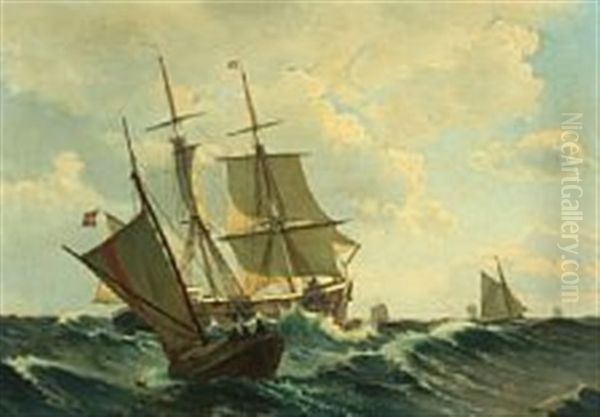
Christian Vigilius Blache stands as one of Denmark's most esteemed marine painters, an artist whose life and work were intrinsically linked to the sea that surrounds his homeland. Born in Aarhus on February 1, 1838, and passing away in Copenhagen on March 14, 1920, Blache's career spanned a period of significant change in both Danish society and its art world. He captured the transition from sail to steam, the dramatic beauty of the Danish coasts, and the enduring relationship between the nation and its maritime environment with remarkable skill and sensitivity. His work, while rooted in the traditions of Danish painting, also embraced newer artistic currents, making him a fascinating figure bridging the late Golden Age and the stirrings of modernism.
Formative Years and Artistic Training
Christian Blache's upbringing in Aarhus, a significant port city, likely fostered his early fascination with the sea and ships. His father, Hans Henrik Blache, was the headmaster of Aarhus Cathedral School, suggesting an environment where education and culture were valued. Before fully committing to art, Blache undertook practical training, initially pursuing a career in shipbuilding. This hands-on experience provided him with an invaluable, intimate understanding of vessel construction, rigging, and how ships behave in the water – knowledge that would deeply inform the accuracy and authenticity of his later paintings.
Recognizing his artistic calling, Blache moved to Copenhagen and enrolled in the Royal Danish Academy of Fine Arts around 1861. He studied there until approximately 1867, a period crucial for honing his technical skills. At the Academy, he came under the tutelage of Carl Frederik Sørensen (1818-1879), who was already a leading figure in Danish marine painting. Sørensen, known for his often dramatic and Romantic depictions of the sea, provided Blache with a strong foundation in the genre. However, Blache would eventually develop his own distinct style, moving towards greater realism and a nuanced observation of light and atmosphere.
Forging an Artistic Identity: Style and Technique

While Blache certainly learned from Sørensen, his artistic path diverged from the high Romanticism often associated with his teacher. Blache's work is characterized by a meticulous attention to detail, grounded in his direct observation of nature and his technical knowledge of ships. He became a master at rendering the textures of water, from calm, reflective harbour surfaces to the turbulent energy of storm-tossed waves. His skies are equally expressive, capturing the changing moods of the maritime climate, often playing a crucial role in the overall atmosphere of the painting.
Blache's style evolved throughout his career. While his earlier works might show stronger ties to the Romantic tradition inherited from Sørensen and the Danish Golden Age painters like Christoffer Wilhelm Eckersberg (1783-1853), who emphasized careful study from life, Blache increasingly incorporated elements associated with Realism. He was particularly adept at capturing the effects of light and air, suggesting an awareness of contemporary European art movements, including the burgeoning Impressionism.
Though not an Impressionist in the French sense – he rarely dissolved form completely into light and colour – Blache's handling of light, his atmospheric sensitivity, and sometimes looser brushwork, particularly in studies or specific passages, reveal an artist responsive to new ways of seeing and painting. He excelled at depicting the specific light conditions of the Nordic coasts, whether the crisp clarity of a summer day or the dramatic gloom of an impending storm. This blend of accuracy, atmospheric depth, and subtle modern tendencies defined his unique contribution.
The Call of the Sea: Subjects and Themes
Blache's oeuvre is overwhelmingly dedicated to the sea. His primary subjects were the coasts and waters of Denmark, particularly the North Sea coast around Skagen and the Kattegat. He travelled extensively, however, capturing scenes from Norway, Sweden, the Faroe Islands, and Iceland, broadening his repertoire of northern maritime landscapes. His paintings depict a wide array of vessels, reflecting the maritime life of his time: traditional fishing boats battling the elements, elegant sailing ships navigating coastal waters, the emerging presence of steamships marking technological change, and formidable naval vessels representing national pride.
He was drawn to both the calm and the fury of the sea. Many works depict tranquil harbour scenes, such as the bustling Nyhavn in Copenhagen, with ships moored peacefully. Others capture the raw power of nature, featuring dramatic storms, shipwrecks, and the heroic efforts of coastal rescue teams. These latter scenes, often filled with dynamic movement and palpable tension, showcase his ability to convey narrative and emotion through the depiction of maritime events.

A recurring theme is the interplay between ships and the coastline, exploring the relationship between human activity and the natural environment. He meticulously rendered the details of rigging, the curve of a hull, and the texture of sails, demonstrating his deep familiarity gained from his early shipbuilding training. His landscapes often feature recognizable coastal formations, lighthouses, and seaside towns, grounding his marine subjects within specific Danish locales.
Journeys and International Recognition
Blache's reputation was not confined to Denmark. He undertook numerous study trips throughout his career, visiting the Netherlands, Belgium, Paris, and Italy, among other places. These travels exposed him to different artistic traditions and landscapes, enriching his perspective. His participation in major international exhibitions significantly boosted his profile abroad.
His works were shown with great success at the Paris World Fairs of 1878 and 1889. This exposure brought him considerable acclaim and led to numerous commissions from both Danish and international patrons, including European nobility and royalty. He received several honours for his work, including the prestigious Thorvaldsen Medal in 1887, Denmark's highest artistic accolade. In 1888, he was elected a member of the Royal Danish Academy of Fine Arts and was later awarded the title of Professor, cementing his status within the Danish art establishment.
Navigating the Danish Art Scene: Contemporaries and Context
Christian Blache worked during a dynamic period in Danish art history. He emerged after the Golden Age had peaked but inherited its emphasis on observation and national subjects. He was a contemporary of other significant Danish marine painters, including his teacher C.F. Sørensen, and the brothers Anton Melbye (1818-1875) and Vilhelm Melbye (1824-1882), who also enjoyed international success. Carl Locher (1851-1915), another prominent marine specialist, was a younger contemporary with whom Blache shared an interest in the Skagen region, although Locher became more closely associated with the Skagen Painters group.
Blache's career overlapped with the rise of the Skagen Painters, including P.S. Krøyer (1851-1909), Michael Ancher (1849-1927), and Anna Ancher (1859-1935). While Blache often painted scenes at Skagen, his focus remained primarily on the sea and ships, whereas the Skagen Painters are perhaps best known for their depictions of the fishermen's lives, social gatherings, and the unique coastal light, often with a more overtly Impressionistic or Realist style. Other key figures of the 'Modern Breakthrough' in Danish art, such as Laurits Tuxen (1853-1927) and the influential critic and painter Karl Madsen (1855-1938), were also part of Blache's artistic milieu.
Compared to the more radical stylistic innovations of some Skagen painters or early Danish Impressionists like Theodor Philipsen (1840-1920), Blache might be seen as occupying a more moderate position. He successfully integrated newer tendencies towards realism and atmospheric light effects without fully abandoning the detailed rendering and compositional structures inherited from the earlier 19th century. His contemporaries also included figures like the poet and painter Holger Drachmann (1846-1908), another Skagen enthusiast, and landscape painters such as Vilhelm Kyhn (1819-1903), representing the more traditional wing of Danish art. Internationally, his work resonates with the broader 19th-century interest in marine painting seen in artists across Europe, from the Dutch tradition to French Realists like Gustave Courbet (1819-1877) or atmospheric painters like Claude Monet (1840-1926) in his early coastal scenes, though Blache maintained his distinct Nordic sensibility.
Masterworks: A Closer Look
Several paintings stand out as representative of Blache's skill and thematic interests. His depictions of lifeboat rescues, such as Redningsbaaden kører ud (The Lifeboat Goes Out), are powerful examples of his ability to capture drama and human resilience against the forces of nature. These works often feature dynamic compositions, energetic brushwork depicting spray and waves, and a palpable sense of urgency.
Works like Fra Kysten ved Hulsig (From the Coast at Hulsig, 1864) showcase his talent for rendering specific coastal landscapes, capturing the dunes, sparse vegetation, and expansive beaches under wide northern skies. His ship portraits, whether of naval vessels like Et dansk Linieskib for Kysten (A Danish Ship of the Line off the Coast) or humble fishing boats, are marked by their accuracy and the convincing depiction of the vessel's interaction with the water and wind.
His views of Copenhagen's harbour, particularly Nyhavn, capture the bustling maritime life of the capital. Paintings like The Harbour (specific date varies by work) often depict the colourful facades of the buildings alongside meticulously rendered ships, blending urban scenery with his primary marine focus. Another example, Seascape with Sailing Ships and Mountains in the Background (1872), highlights his ability to create serene compositions, balancing the elements of sea, sky, and land with distant vessels adding scale and interest. A late work, Danish Frigate with Several Other Sailing Ships Anchored in the Roads of Øresund (1920), demonstrates his continued dedication to maritime subjects until the very end of his life.
Across his diverse subjects, Blache consistently demonstrated technical mastery in depicting the complex interplay of light on water, the structure and movement of ships, and the vastness and changing character of the sea and sky. His works are both documents of maritime life and evocative expressions of the sea's enduring power and beauty.
Later Years and Enduring Legacy
Christian Blache remained an active and respected figure in the Danish art world throughout his later years. His appointment as a Professor at the Academy in 1888 solidified his position. He continued to paint and exhibit, maintaining his focus on marine subjects until his death in Copenhagen in 1920 at the age of 82.
His legacy lies in his position as one of Denmark's foremost marine painters, a successor to the Golden Age masters who adapted his style to incorporate elements of Realism and an Impressionistic sensitivity to light and atmosphere. He documented a crucial era of maritime history, capturing the coexistence and transition from sail to steam power. His deep knowledge of ships lent an authenticity to his work that few contemporaries could match.
While perhaps not as revolutionary as some figures of the Modern Breakthrough, Blache played a vital role in carrying forward and evolving the tradition of Danish marine painting. His works are held in major Danish museum collections, including the Statens Museum for Kunst (National Gallery of Denmark) in Copenhagen and ARoS Aarhus Art Museum, as well as in numerous private collections. His paintings continue to be sought after on the art market, appreciated for their technical skill, atmospheric beauty, and historical significance. He remains a key figure for understanding the development of Danish art in the latter half of the 19th century and a master chronicler of his nation's profound connection to the sea.
Conclusion
Christian Blache dedicated his artistic life to capturing the essence of the sea and maritime life, primarily around his native Denmark. From his early training in shipbuilding to his studies under C.F. Sørensen and his long, productive career, he developed a distinctive style characterized by meticulous observation, technical accuracy, and a profound sensitivity to the changing moods of the ocean and sky. He successfully navigated the transition from Romanticism towards Realism, incorporating subtle influences from Impressionism to create works of great atmospheric depth. Through his dramatic storm scenes, tranquil harbour views, and precise ship portraits, Blache not only documented an era but also conveyed the enduring power and allure of the maritime world, securing his place as a central figure in the rich history of Danish art.